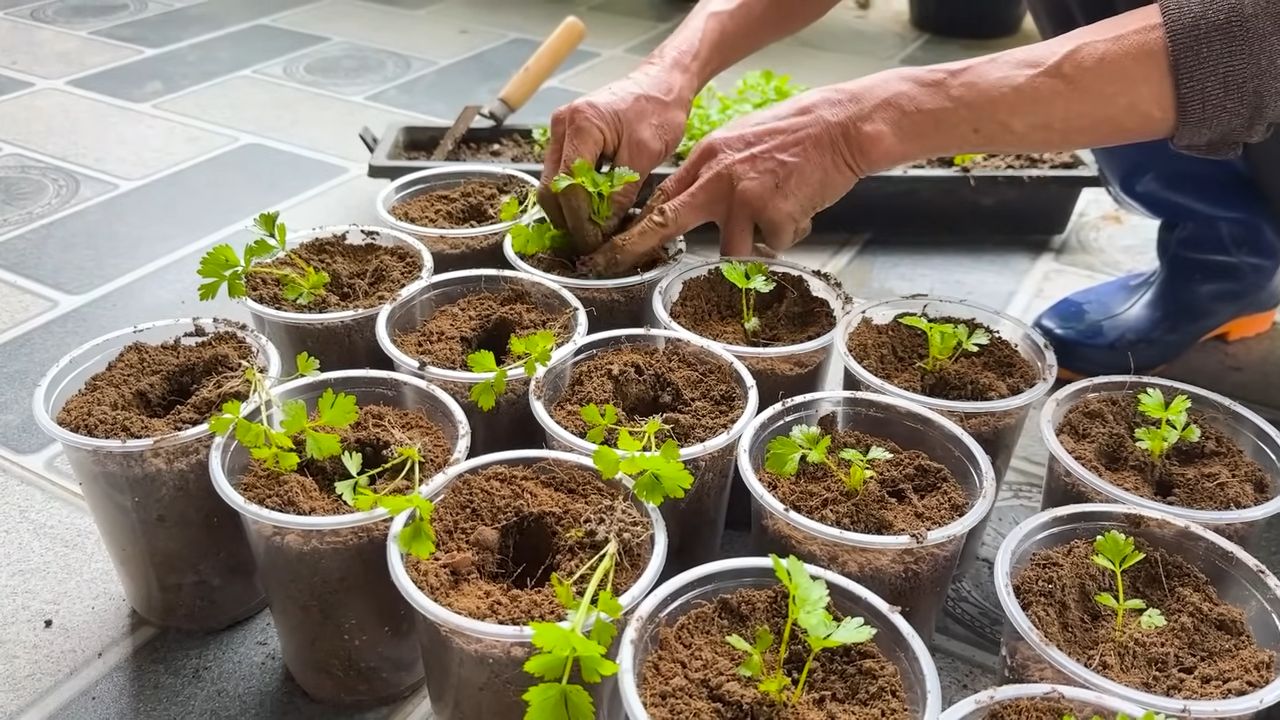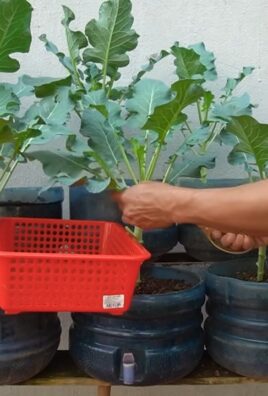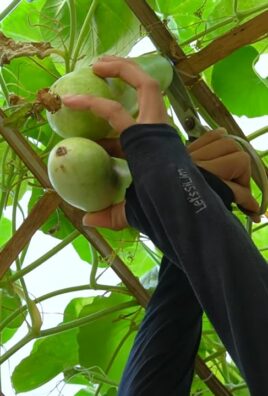Growing Celery on Stones: Sounds a bit unconventional, right? But trust me, this simple DIY trick can revolutionize your home gardening game! Forget sprawling gardens and endless soil preparation; we’re talking about bringing the crisp, refreshing taste of homegrown celery right to your kitchen counter with just a few stones and some water.
Celery, with its satisfying crunch and subtle flavor, has been enjoyed for centuries. Originating in the Mediterranean, it was initially valued for its medicinal properties before becoming a culinary staple. Now, you don’t need a sprawling farm to enjoy its fresh taste.
So, why should you try growing celery on stones? Well, for starters, it’s incredibly space-saving, perfect for apartment dwellers or anyone with limited outdoor space. Plus, it’s a fantastic way to reduce food waste by regrowing celery from the base you’d normally discard. Imagine always having fresh celery on hand for salads, soups, or a healthy snack! This method is not only easy and cost-effective, but it’s also a fun and educational project for the whole family. I’m excited to show you how easy it is to start growing celery on stones and enjoy the fruits (or rather, vegetables!) of your labor in no time!

Sellerie auf Steinen ziehen: Ein DIY-Projekt für den Fenstergarten
Hallo liebe Gartenfreunde! Habt ihr euch jemals gefragt, ob man Sellerie einfach so auf Steinen ziehen kann? Die Antwort ist: Ja, das geht! Und es ist ein super einfaches und lohnendes DIY-Projekt, perfekt für alle, die keinen Garten haben oder einfach nur etwas Neues ausprobieren möchten. Ich zeige euch, wie ihr aus einem einfachen Selleriestrunk frischen Sellerie in eurem Fenstergarten ziehen könnt.
Was ihr braucht:
* Ein Selleriestrunk (am besten mit Wurzelansatz)
* Ein Gefäß (Glas, Schale, Topf – Hauptsache wasserdicht)
* Steine (Kieselsteine, Ziersteine, Flusssteine – alles ist erlaubt!)
* Wasser
* Ein sonniger Platz am Fenster
Warum Sellerie auf Steinen?
Sellerie auf Steinen zu ziehen, ist nicht nur eine platzsparende und dekorative Methode, sondern auch eine tolle Möglichkeit, Gemüsereste zu verwerten. Anstatt den Selleriestrunk wegzuwerfen, könnt ihr ihn einfach wieder zum Leben erwecken und euch über frisches Grün freuen. Außerdem ist es ein spannendes Projekt, um Kindern die Grundlagen des Pflanzenwachstums näherzubringen.
Schritt-für-Schritt-Anleitung: Sellerie-Revival
1. Den Selleriestrunk vorbereiten:
* Schneidet den Selleriestrunk etwa 5-7 cm vom unteren Ende ab. Achtet darauf, dass der Wurzelansatz noch vorhanden ist.
* Entfernt die äußeren, welken oder beschädigten Stiele. Die inneren, frischen Stiele könnt ihr dranlassen.
* Lasst den Strunk ein paar Stunden an der Luft trocknen, damit die Schnittfläche etwas abtrocknen kann. Das hilft, Fäulnis vorzubeugen.
2. Das Gefäß vorbereiten:
* Reinigt das Gefäß gründlich mit Wasser und Spülmittel.
* Füllt das Gefäß mit den Steinen. Die Steine sollten etwa 2/3 des Gefäßes füllen.
* Achtet darauf, dass die Steine sauber sind, um das Wachstum von Bakterien und Schimmel zu verhindern.
3. Den Selleriestrunk einsetzen:
* Platziert den Selleriestrunk auf den Steinen. Achtet darauf, dass der Wurzelansatz nach unten zeigt.
* Die Steine sollten den Strunk stabilisieren, sodass er nicht umfällt.
* Füllt das Gefäß mit Wasser, bis der untere Teil des Selleriestrunks bedeckt ist. Das Wasser sollte nicht bis zu den frischen Stielen reichen, da diese sonst faulen könnten.
4. Der richtige Standort:
* Stellt das Gefäß an einen hellen, sonnigen Platz am Fenster. Sellerie braucht viel Licht, um gut zu wachsen.
* Vermeidet direkte Mittagssonne, da diese die Blätter verbrennen kann.
* Dreht das Gefäß regelmäßig, damit der Sellerie gleichmäßig wächst.
5. Die Pflege:
* Wechselt das Wasser alle 1-2 Tage, um Fäulnis zu verhindern.
* Achtet darauf, dass der Wasserstand immer ausreichend ist. Der untere Teil des Selleriestrunks sollte immer im Wasser stehen.
* Entfernt regelmäßig welke oder gelbe Blätter.
* Nach einigen Tagen solltet ihr sehen, wie neue Wurzeln und Blätter wachsen.
Geduld ist gefragt: Das Wachstum beobachten
Habt Geduld! Es dauert ein paar Tage, bis ihr die ersten Anzeichen von Wachstum seht. Aber wenn ihr die oben genannten Schritte befolgt, werdet ihr bald mit frischem Selleriegrün belohnt.
Was tun, wenn…?
* Der Selleriestrunk fault: Wenn der Selleriestrunk fault, ist das ein Zeichen dafür, dass zu viel Wasser vorhanden ist oder das Wasser nicht oft genug gewechselt wird. Entfernt den faulen Teil und wechselt das Wasser öfter.
* Der Sellerie wächst nicht: Wenn der Sellerie nicht wächst, kann das an zu wenig Licht liegen. Stellt das Gefäß an einen helleren Ort.
* Die Blätter werden gelb: Gelbe Blätter können ein Zeichen für Nährstoffmangel sein. Ihr könnt dem Wasser etwas Flüssigdünger hinzufügen.
Sellerie ernten und verwenden
Sobald der Sellerie ausreichend gewachsen ist, könnt ihr die Blätter ernten und in euren Gerichten verwenden. Sie eignen sich hervorragend für Suppen, Salate, Smoothies oder als Garnitur. Ihr könnt auch die Stiele ernten, wenn sie dick genug sind.
Langfristige Sellerie-Zucht: Umtopfen in Erde
Wenn ihr euren Sellerie langfristig züchten möchtet, könnt ihr ihn nach einigen Wochen in einen Topf mit Erde umtopfen.
Vorbereitung für das Umtopfen:
1. Den richtigen Zeitpunkt wählen: Wartet, bis der Sellerie ausreichend Wurzeln gebildet hat. Die Wurzeln sollten mindestens 5 cm lang sein.
2. Einen geeigneten Topf auswählen: Wählt einen Topf mit ausreichend Platz für die Wurzeln. Ein Topf mit einem Durchmesser von mindestens 15 cm ist ideal.
3. Die richtige Erde verwenden: Verwendet eine hochwertige Blumenerde oder eine Mischung aus Blumenerde und Kompost.
Der Umtopf-Prozess:
1. Den Topf vorbereiten: Füllt den Topf mit Erde, lasst aber oben noch etwas Platz.
2. Den Sellerie vorsichtig aus dem Gefäß nehmen: Löst den Sellerie vorsichtig von den Steinen. Achtet darauf, die Wurzeln nicht zu beschädigen.
3. Den Sellerie in den Topf pflanzen: Setzt den Sellerie in die Mitte des Topfes und füllt den Topf mit Erde auf.
4. Angießen: Gießt den Sellerie gründlich an.
Pflege nach dem Umtopfen:
1. Der richtige Standort: Stellt den Topf an einen hellen, sonnigen Platz.
2. Regelmäßiges Gießen: Gießt den Sellerie regelmäßig, aber vermeidet Staunässe.
3. Düngen: Düngt den Sellerie regelmäßig mit einem Flüssigdünger.
Weitere Tipps und Tricks
* Sellerie aus dem Supermarkt: Ihr könnt auch Sellerie aus dem Supermarkt verwenden. Achtet aber darauf, dass der Strunk noch frisch und fest ist.
* Verschiedene Selleriesorten: Es gibt verschiedene Selleriesorten, die sich in Geschmack und Aussehen unterscheiden. Probiert verschiedene Sorten aus, um euren Favoriten zu finden.
* Sellerie als Dekoration: Sellerie auf Steinen ist nicht nur eine praktische, sondern auch eine dekorative Idee. Ihr könnt das Gefäß mit verschiedenen Steinen und Pflanzen dekorieren.
Fazit: Ein einfaches und lohnendes Projekt
Sellerie auf Steinen zu ziehen ist ein einfaches und lohnendes DIY-Projekt, das jeder ausprobieren kann. Es ist eine tolle Möglichkeit, Gemüsereste zu verwerten, frisches Grün in die Wohnung zu bringen und Kindern die Grundlagen des Pflanzenwachstums näherzubringen. Also, worauf wartet ihr noch? Holt euch einen Selleriestrunk und legt los! Ich wünsche euch viel Spaß beim Gärtnern!

Conclusion
So, there you have it! Growing celery on stones isn’t just a quirky gardening experiment; it’s a genuinely effective way to breathe new life into those celery stalks you might otherwise toss in the compost. It’s a testament to the resilience of nature and a fantastic opportunity to engage with the growing process in a unique and rewarding way. This method allows you to enjoy fresh, crisp celery without the need for extensive garden space or complicated gardening techniques.
Why is this DIY trick a must-try? Because it’s simple, sustainable, and surprisingly satisfying. It transforms food waste into a source of fresh produce, reduces your grocery bill, and adds a touch of green to your kitchen windowsill. Plus, it’s a fantastic conversation starter! Imagine the look on your friends’ faces when you tell them you’re growing celery on stones.
But the fun doesn’t stop there! Feel free to experiment with variations. Try using different types of stones – river rocks, lava rocks, or even decorative glass pebbles. You can also experiment with different nutrient solutions. While plain water works well, adding a diluted liquid fertilizer every few weeks can give your celery an extra boost. Consider using rainwater or filtered water for optimal results. Another variation is to try this method with other vegetables like romaine lettuce or bok choy. The possibilities are endless!
Don’t be afraid to get creative and personalize your celery-growing setup. You can even add a small air pump to oxygenate the water, promoting healthier root growth. Just be sure to monitor the water level and change it regularly to prevent algae growth.
We wholeheartedly encourage you to try this DIY trick for growing celery on stones. It’s a fun, educational, and rewarding experience that will connect you with the natural world in a whole new way. It’s also a great project to do with kids, teaching them about plant propagation and sustainable living.
Once you’ve given it a go, we’d love to hear about your experience! Share your photos, tips, and tricks in the comments below. Let us know what worked for you, what challenges you faced, and any creative variations you came up with. Your feedback will help other readers learn and grow their own celery on stones successfully. Let’s build a community of stone-grown celery enthusiasts!
Remember, gardening doesn’t have to be complicated or expensive. Sometimes, the simplest methods are the most effective. So, grab a celery stalk, some stones, and a container of water, and get ready to witness the magic of regeneration. Happy growing!
Frequently Asked Questions (FAQ)
What kind of celery works best for growing on stones?
The best celery for this method is celery that still has its base intact. Look for celery stalks with a firm, healthy base and a cluster of tightly packed stalks. Avoid celery that is wilted, discolored, or has a mushy base. Organic celery is often a good choice, as it is less likely to have been treated with chemicals that could inhibit growth. The fresher the celery, the better the chances of successful regrowth.
How long does it take to see new growth?
You should start to see new growth within a week or two. The exact timeframe will depend on factors such as the temperature, light exposure, and the health of the celery base. Be patient, and make sure to change the water regularly to prevent algae growth. If you don’t see any growth after three weeks, it’s possible that the celery base is not viable, and you may need to try again with a different stalk.
What kind of water should I use?
Tap water is generally fine, but it’s best to let it sit out for 24 hours to allow the chlorine to dissipate. Rainwater or filtered water is even better, as they are free of chemicals that could potentially harm the celery. Avoid using distilled water, as it lacks the minerals that plants need to thrive. Change the water every one to two days to keep it fresh and prevent algae growth.
How much sunlight does the celery need?
Celery needs bright, indirect sunlight. Avoid placing it in direct sunlight, as this can scorch the leaves. A windowsill that receives morning sun or a spot near a bright window is ideal. If you don’t have access to natural light, you can use a grow light to supplement the light.
Can I transplant the celery into soil after it starts growing?
Yes, you can transplant the celery into soil once it has developed a good root system. This will give it more space to grow and access to nutrients. Choose a pot that is at least 6 inches in diameter and fill it with well-draining potting soil. Gently remove the celery from the water and plant it in the pot, being careful not to damage the roots. Water thoroughly and place the pot in a sunny location.
What kind of fertilizer should I use?
If you choose to use fertilizer, a diluted liquid fertilizer is best. Look for a balanced fertilizer with an NPK ratio of 10-10-10 or similar. Dilute the fertilizer to half strength and add it to the water every two to three weeks. Avoid over-fertilizing, as this can damage the celery.
How do I prevent algae growth?
Algae growth is a common problem when growing plants in water. To prevent algae growth, change the water regularly (every one to two days). You can also add a few drops of hydrogen peroxide to the water, which will help to kill algae. Avoid placing the celery in direct sunlight, as this can promote algae growth. You can also use an opaque container to block light from reaching the water.
Can I eat the celery that grows from the base?
Yes, you can eat the celery that grows from the base. However, it’s important to note that the celery grown from the base may not be as flavorful or tender as celery grown from seed. It’s best used in soups, stews, or other cooked dishes.
What if my celery doesn’t grow?
If your celery doesn’t grow, there could be several reasons why. The celery base may not be viable, the water may not be fresh, or the celery may not be getting enough light. Try again with a different celery stalk, make sure to change the water regularly, and provide the celery with bright, indirect sunlight. If you still don’t see any growth after several weeks, it’s possible that the celery is not going to grow.
Is this method sustainable?
Yes, growing celery on stones is a sustainable method of gardening. It allows you to reuse food waste and reduce your reliance on store-bought produce. It also requires minimal resources, such as water and fertilizer. By growing your own celery, you can reduce your carbon footprint and contribute to a more sustainable lifestyle.




Leave a Comment